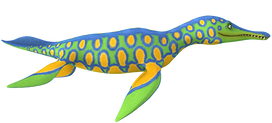
Polycotylus is a genus of plesiosaur within the family Polycotylidae.[1] The type species is P. latippinis and was named by American paleontologist Edward Drinker Cope in 1869. Eleven other species have been identified. The name means 'much-cupped vertebrae', referring to the shape of the vertebrae. It lived in the Western Interior Seaway of North America toward the end of the Cretaceous. One fossil preserves an adult with a single large fetus inside of it, indicating that Polycotylus gave live birth, an unusual adaptation among reptiles.
Description
Like all plesiosaurs, Polycotylus was a large marine reptile with a short tail, large flippers, and a broad body. It has a short neck and a long head, and was about 5 metres (16 ft) long.[2] It has more neck vertebrae than other polycotylids, however. Polycotylus is thought to be a basal polycotylid because it has more vertebrae in its neck (a feature that links it with long-necked ancestors) and its humerus has a more primitive shape. The long ischia of the pelvis are a distinguishing feature of Polycotylus, as are thick teeth with striations on their surfaces, a narrow pterygoid bone on the palate and a low sagittal crest on top of the skull.
History
Edward Drinker Cope named Polycotylus from the Niobrara Formation in Kansas in 1869. The holotype bones from which he based his description were fragmentary, representing only a small portion of the skeleton. A more complete skeleton was later found in Kansas and was described in 1906. A nearly complete skeleton was found in 1949 from the Mooreville Chalk Formation in Alabama, but was not described until 2002. A new species, P. sopozkoi, from Russia was described in 2016.